Which insect control devices will suit your restaurant and what factors should you consider?
Attracting customers and turning them into repeat customers is the goal. Putting together a memorable dining experience. Fabulous fit outs, fresh local produce, creative menus and smiling staff.
Enter the customer, eager to share all on review sites like Trip Advisor and Zomato. While enthusiastic reviews are always pleasure, it is often an oversight, a gripe or a fly that becomes the focal point of the post.
While it is impossible to control every aspect of the customer experience, I aim to ensure that it is not the great Australian a blow fly that brings you undone.
Specialising in providing piece of mind, I will help you defend your good reputation and all the hard work that goes in every day, behind the scenes, in every restaurant.
This article will help you make sense of the restaurant insect control options available to keep the flies away from your customers and out of your kitchen.
Whether you want to prevent a fly problem or looking to solve one, l can help. Lets look at your restaurant insect control options.
Restaurant Pest Control Checklist
The basic principles of pest prevention and hygiene are always relevant. I am betting there are many things you already do to make your premises and procedures less attractive to pests.
Start with your restaurant and your staff.
- As good hygiene and procedure are vital for control of all pests, ensure a staff member runs through this restaurant pest control checklist.
It will identify potential problem areas inside and around the perimeter of your restaurant. It will highlight areas to keep an eye on and possibly give you a few things you can tweak to discourage pests. - Get all your employees on board. Next team meeting have a refresher on ways to keep your front and back of house spaces and procedures as fly proof and unattractive to pests as possible. The restaurant insect control checklist will assist you, giving you key points to discuss.
Restaurant pest control is a team sport.
Get your staff onboard.
Moisture and food, garbage and garden beds all provide places for flies to feed and lay eggs. Flies will tend to linger where their basic needs are met. Few will stay in dry, clean areas. A continuous sanitation effort is needed to ensure flies do not hang around.
It is essential that action is taken to prevent pests entering your space and conditions within the premises discourage them from staying. Before selecting insect control contraptions, you need to consider your environment.
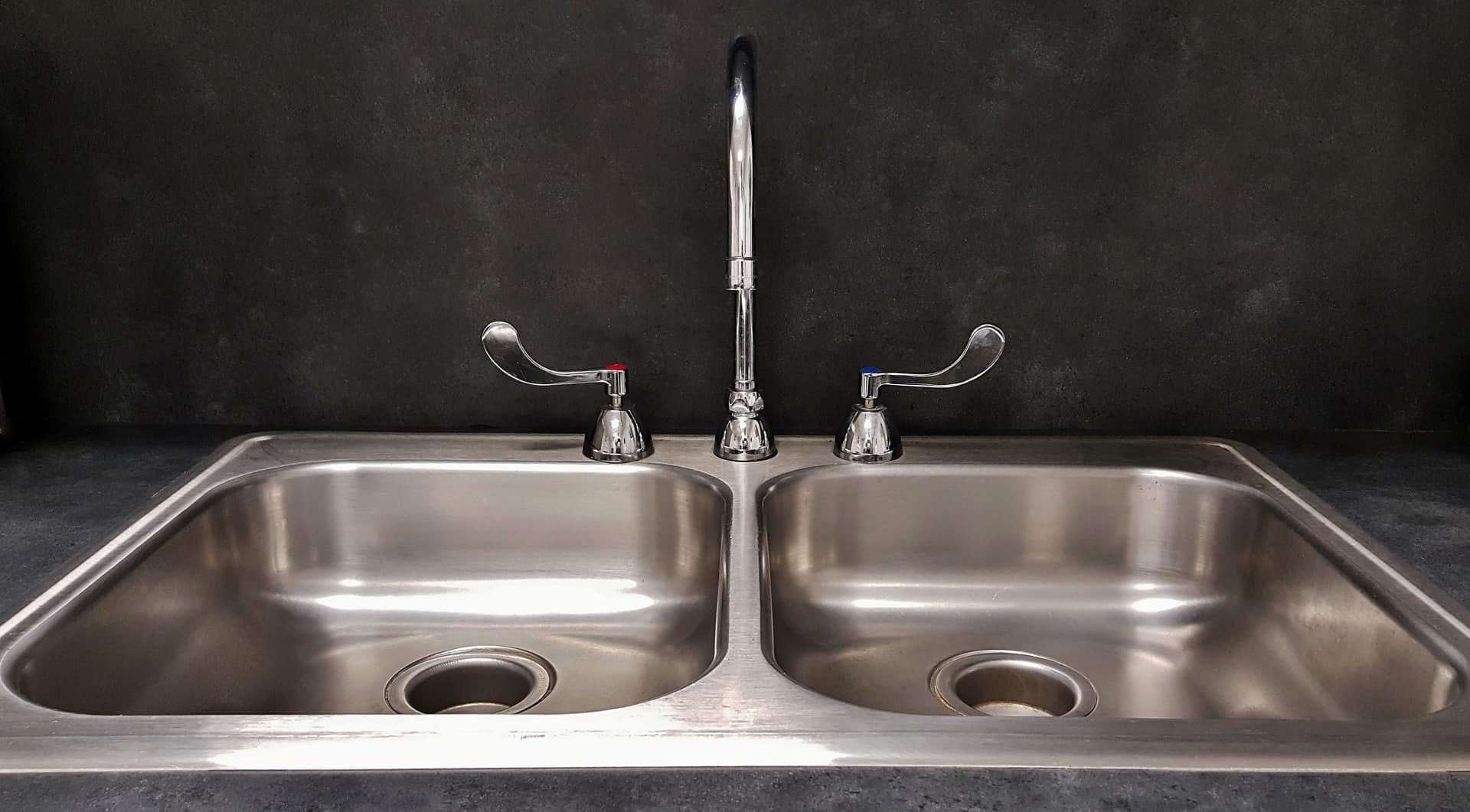
What’s right for you? Consider your restaurant environment.
How many doors and windows?
Australians love bringing the outdoors inside. Open doors and windows are loved by both the diner and the insect. The number of open doors and windows effect the way you tackle flying pests. The less points of entry, the easier to create insect proof barriers. Standard single doors are going to be easier to fly proof than bi fold doors on three sides of your building.
Is there a breeze?
Breeze plays a role in deciding on the best solution for tackling flying pests. Premises with a strong, regular breeze or a tunnel breeze travelling through the building, require extra attention. When thinking about your space, note the stiller, quieter air spaces. Which direction does the breeze come from and which way does the air flow through your restaurant? Is the back door usually open?
Equipment with air intakes will affect air flow. You do not want to be setting up spray products beside air conditioners, air curtains or rangehoods.
Light and bright
Flies are naturally attracted to sunlight. You will often find them dead in large glass front windows. They were trying to get outside, attracted to the natural light. The amount of interior light is going to impact your fly control choice. Bright spaces with the sunshine beaming in make it difficult for fly traps that rely on an artificial light source. Consider your space during the sunniest part of the day. If the area is bright, steer away from traps using light as an attractant.
Power points
Solutions that involve a light source or a temperature-controlled attractant are going to require power. Install gizmos requiring an electrical source near power points, unless you are prepared to engage an electrical contractor or are able to run extension cords. Consider this extra expense when doing your costings.
Replacements, refills and dusting
Glue boards gather dust. Dusty glue does not trap insects. Glue boards need regular replacement. Light attractants will require dusting, so the light source is not diluted. Whatever option you select, maintenance is key. When trapping, catching or zapping insects, once dead, they must be removed frequently to prevent accumulation. Dead insects attract more insects.
On the upside, glue board traps allow you to inspect the type of insect caught and monitor numbers of caught insects. This could possibly give you the heads up of early infestation. As a chef of 15 years, l know there is precious little time to be monitoring insects. You just need them gone. Food safe insect spray is effective at repelling all flying insects, no cleaning dead insects or monitoring. Just turn them around mid-air and send them on their way. Spray’s require refilling every 6 weeks.
Odour control
Flies are attracted to odours. The average fly will travel 4 kms in 4 days. To stop attracting flies from all around the neighbourhood, you need to keep the smells to a minimum.
- Keep your rangehood’s grease filters clean and well maintained
- Keep your dumpsters in the shade if possible
- Keeps bin lids closed/do not over fill
- Insist your restaurant has a sealed bag policy for all kitchen waste
- Air curtains help keep air conditioning and cooking smells inside, helping deter flying pests
- More about that in the restaurant pest control checklist
How Far Can House Flies Fly? Read the research from Kentucky University. 4km’s in four days. The fittest flies covered 20kms in four days!
Room Size
What size room are you trying to pest proof? Regardless of the control option, the larger the space, the more units required.
There are several things to consider when tackling spaces.
Is it easier to:
- Cover problem areas within the room?
- Cover the entries and exits and windows in the room?
- Cover the whole space in the room?
When it comes to fly control – the stiller the air space, the less units required and the better the coverage.
Suitable attachment points
When covering spaces, seating areas and food prep areas, there needs to be suitable attachment points within the vicinity.
Flying insects can only see an insect light trap that is in “line-of-sight”. If there are multiple areas you are trying to protect, position your traps so that at least one can be seen from each area.
Surrounding areas
Water
Ornamental ponds should not be considered. Still water may gives rise to insects that rely on water to breed. A readily available source of water is a requirement for successful rat populations. Birds may be attracted to the site and may roost or nest on the building. This leads to problems with fouling and eventually problems with insects as the two are often linked.
Certain flying insects require stagnating water to breed in. Guttering should have sufficient fall to allow good rainwater run off.
Leaf Litter
Insects and rodents may take advantage of leaf litter accumulation. These areas should feature on cleaning schedules, especially during autumn when leaf fall is high.
Bin Areas
Site bin areas 10 metres from buildings to keep pests at a distance. Water run off after cleaning is important as pooling water from overflow will encourage various pests, particularly flies. Waste drainage channels should be fitted with grids that allow waste to pass through and not clog. Use grids that can be removed easily for cleaning. Provide shade to waste areas to reduce odours.
Building Colour Schemes
Building colours can be attractive to insects depending on where they fall in the colour spectrum. Avoid white or light-yellow surfaces due to their ability to reflect UV light. This should be considered when deciding the overall building colour scheme and can also be relevant to smaller scale studies, such as the colour of surfaces around entryways. Darker blue or green colours are preferable.
What are your problem pests?
The presence of pests in any food handling premises is unacceptable.
They pose risks including:
- The spread of disease via pathogens transferred from the gut and external surface of the pest
- Damage to product or packaging
- Contamination of work surfaces and foodstuffs
- Adverse public opinion and loss of reputation
What to do?
Prevent the introduction of pests onto the site and reduce the conditions that encourage their presence. I emphasise prevention through good hygiene, stock management and exclusion practices.
Restaurant pests can include:
- Flies
- Fermentation flies
- Stored goods pests
- Cockroaches
- Ants and rodents
Where do pests hide?
Pests are most active at night and hide in dark places, including:
- Under and behind electrical, heating and cooking appliances
- Under washing and hand washing facilities
- Under and in boxes, packaging and food storage containers
- Inside wall cavities
- In cracks and crevices
- Behind equipment
- In disused or ‘mothballed’ equipment.
Indicators of a problem include signs of pests such as droppings, gnaw marks on packaging or food stuffs and dead insects. Keep your eye out for situation that may increase the likelihood of pest infestations.
How are the pests gaining access?
The ideal solution is to prevent the pest entering in the first place. Fix screens, seal up gaps along floors, ceilings and walls. Ensure doors and windows are suitably fitted and screened where possible. Add a door seal piece along the bottom of doors, especially the door leading to the loading dock /bin area. Remove likely habitats surrounding your building. Inspect deliveries. If possible, do not bring cardboard into the kitchen. It can harbour insect eggs.
Specific pests
Flies
The Fly Eater Plus Trap
The Fly Eater Plus Fly Trap Available on the products page. $9.99 Add sachet of non toxic attractant and water. Hang trap in a sunny spot to attract flies. Do not place close to back door or you will be attracting flies in. Very smelly once they begin to fill. Suitable locations include your outdoor rubbish bin enclosure, a perimeter fence, hanging out of a tree in the car park etc.
Restaurant Fly Control Spray (HACCP Approved)
If you have a bright, low breeze restaurant, food safe fly control spray is a very effective and cost-efficient option. The hardware is straight forward making it easy to manage. It will require 3 minutes per system, every 6 weeks. So whilst being time efficient you are also avoiding the call out costs charged by pest control companies. Food safe fly control is ideal for indoor areas in both low or high light areas. This type of fly control works by creating a fly free zone. Insects entering the air space must leave as they are unable to break down the active ingredient. This means there are no insect glue boards to replace or dead insect catchment trays to clean. The insect spray is not a fast knockdown, meaning insects do not die on the premises. Insects will remove themselves, leaving you nothing to clean up. If unable to leave during closing hours, the insect will die.
Not suitable for high breeze areas. Cannot be installed directly over food prep or chef’s chopping boards. Option here is to install above walkways, beside doorway, over rubbish bins, mops, fridges etc.
Available on the products page
Granules
For the control of flies in turf, garden beds, bin areas, external surrounds of buildings and structures. Keeping granules out of the weather will extend the product life. Add water to make a paste and apply with a paint brush. Paint inside bin lids, top of fence in bin enclosure, under eaves etc.
Insectashield
Suitable for spraying around bin recesses and enclosures, inside bin lids, under outdoor dining tables, loading dock areas and backdoor fly wire screens. The water based product can be put on a cloth and used to wipe down seating areas, counter fronts, uprights, signage.
Will not harm surfaces. Provides residual protection for several weeks. Available on the products page
Fermentation flies
This group of flies includes all the littler, pinhead sized flies. They like to feed on sugary yeasty liquids, fruits, residue left in beverage containers, filth in drains and liquid sitting in cracked tiles.
Left to their own device, they will often be found beneath bar areas, in the dark sticky recesses. When disturbed, they retreat up to the bulk heads. On closer inspection you will see tiny black/brown spots on bulkhead edges, wall edges and above doorways. These little spots are their droppings. Fermentation flies will congregate overhead until it is quiet (closing time) and they can resume their activities down low again.
They like wet mop and broom heads and dirty linen bags. Fermentation flies breed and feed down low. They require moisture, condensation, pooled water in cracked tiles, leaking pipes etc. to feed and breed. This group of flies are happiest at 26 degrees C. They breed and develop in numbers, fast. A few vinegar flies can turn into a cloud in a short period of time.
They tend to persist year-round in the northern half of Australia because of the warmer winters. They are worse during Summer. I have had the most success in treating all varieties of fermentation fly down low where they feed, using the automatic fly spray dispensers.
In these pictures automatic dispensers are zip tied under the bar. The spray is dispensed across the tun drain and the overflow bucket where the vinegar flies like to feed on the yeasty, sugary beer dregs.
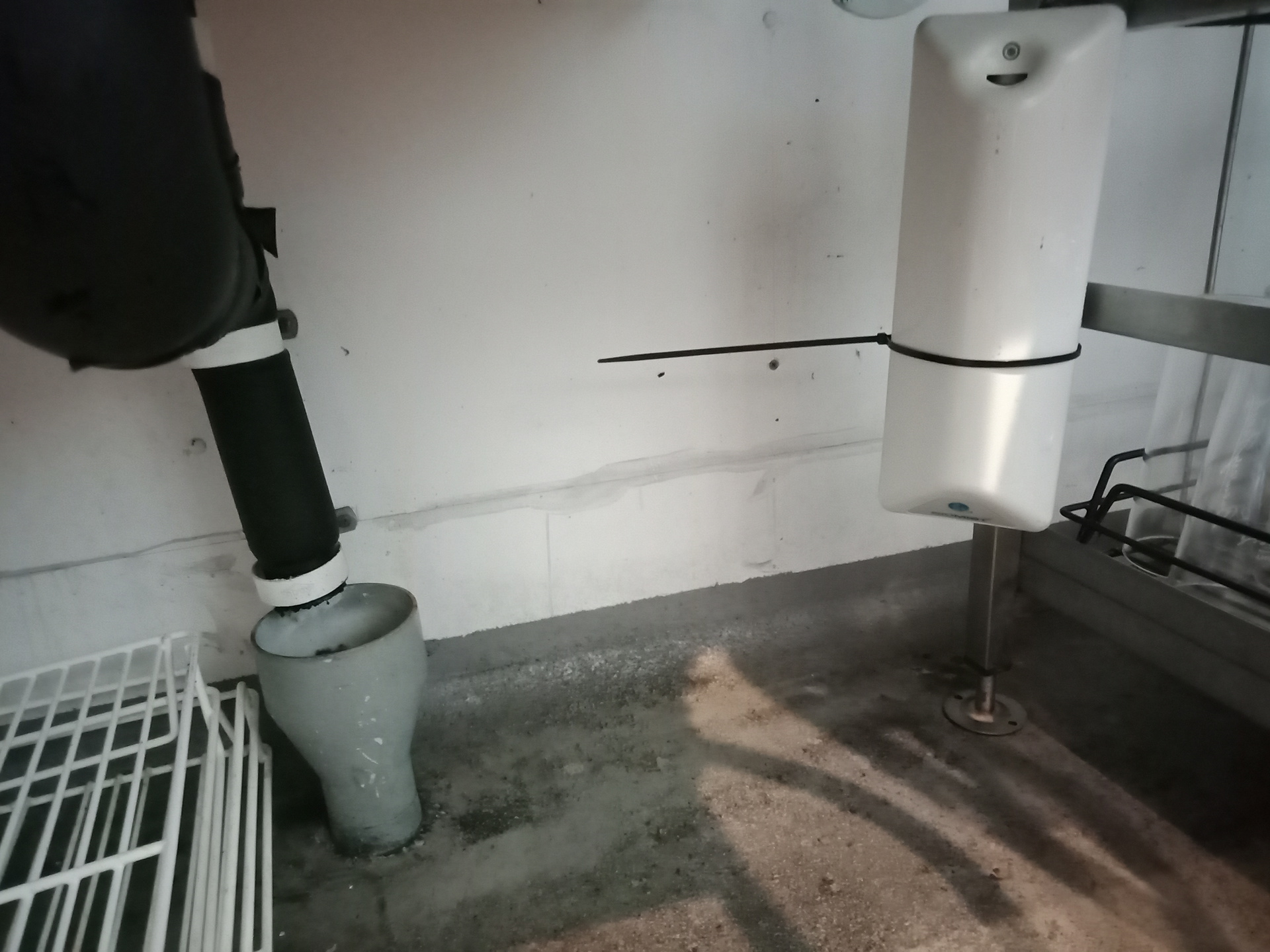
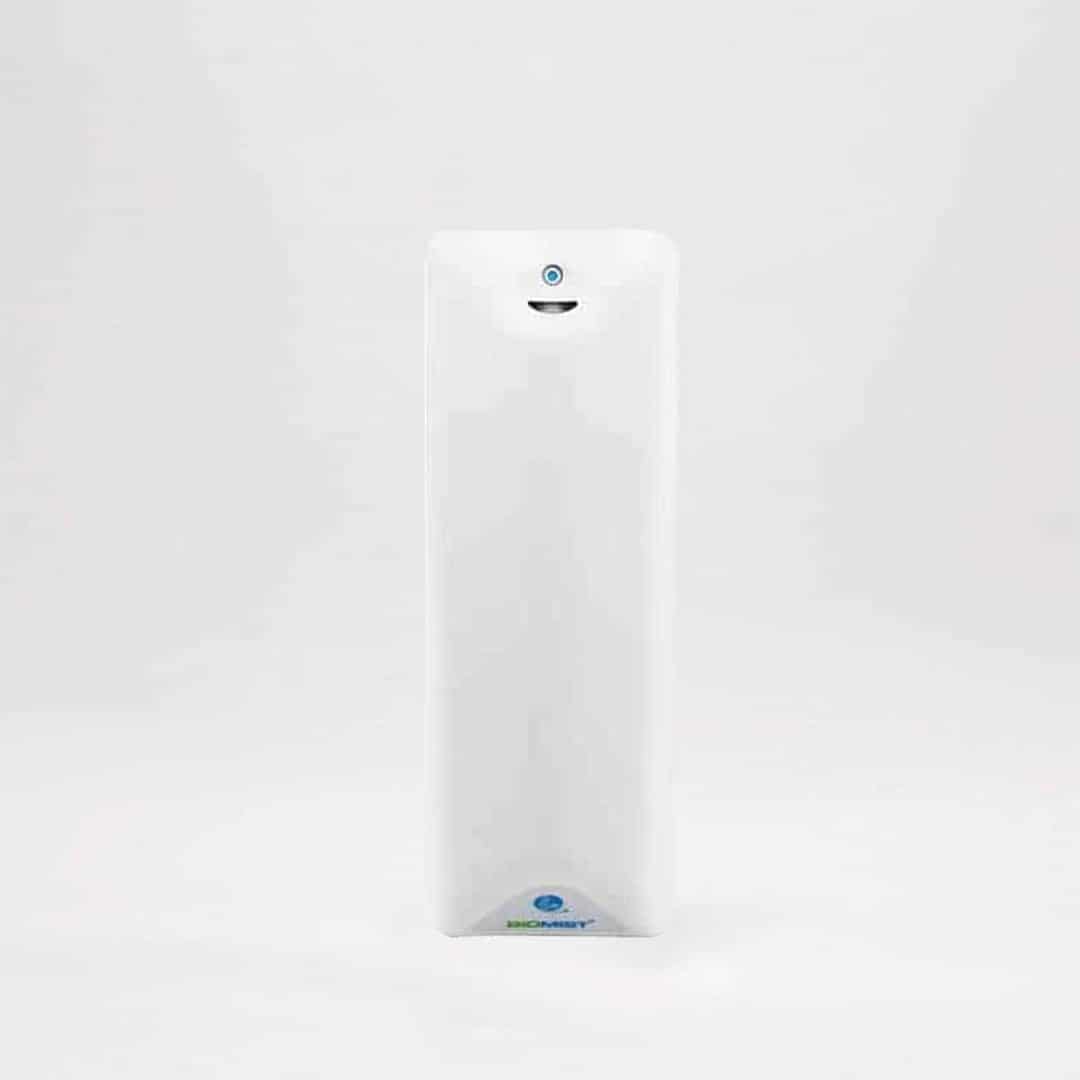
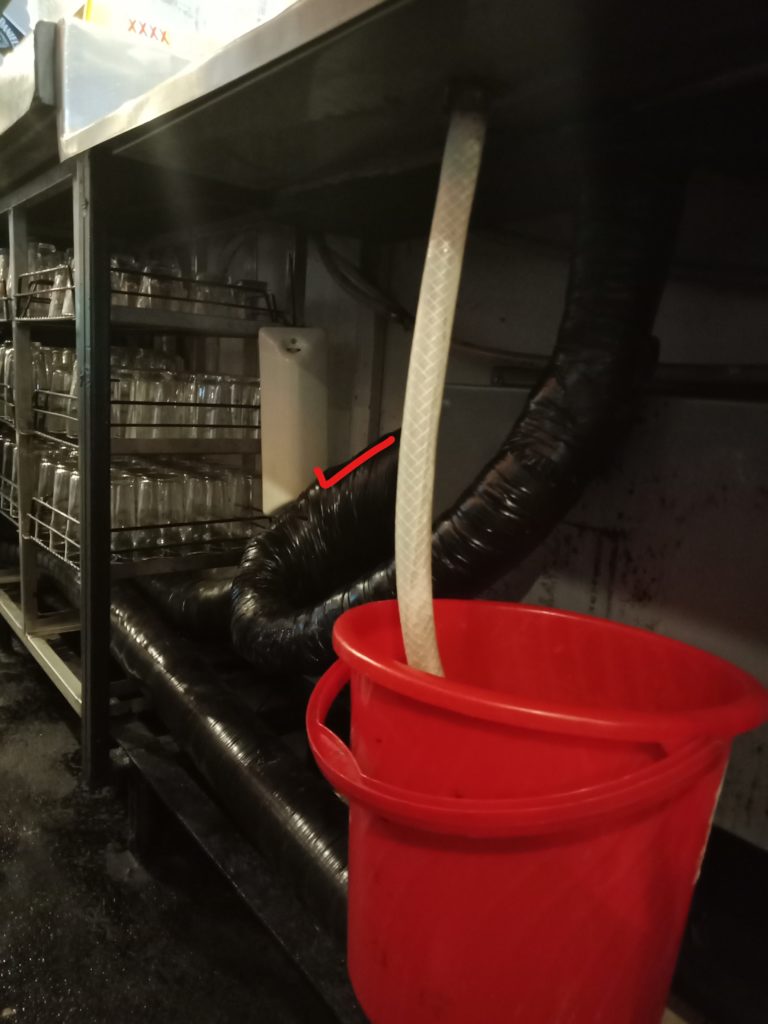
Stored product insects
Stored product insects (SPI) are significant pests. They spend most of their time, including breeding, hidden in their chosen food type. Inspection and early detection can prove difficult. Commodities attacked include cereals, nuts, dried fruit and pulses.
Common Stored Product Pests
SPI fall into two main categories:
- Primary – those having the ability to penetrate whole grains.
These are further sub-divided into:- Internal – species whose life cycle is completed within the grain or bean. The hole left by the exiting adult is characteristic.
- External – species whose life cycle is completed outside the grain
- Secondary – feed on the fungus present in poorly stored or damaged product.
Particular species of SPI generally infest specific types of product:
Beans, peas and similar foods
Bruchid beetles
Coffee, cocoa
Flour beetles, Merchant grain beetles, Warehouse moths.
Cheese
Mites, Larder beetle, Copra beetle
Dried fruit
Indian meal moth, Merchant grain beetles, Tobacco beetle, Dried fruit beetle, Mites
Dried vegetables
Indian meal moth, miscellaneous general feeders
Flour and milled cereal products
Flour beetles, Mill moth, Indian meal moth, Cadelle, Flat grain beetle, Mites
Grain wheat, rice, corn & other cereals
Rice weevil, Grain weevil, Lesser grain borer, Saw- toothed grain beetle, Cadelle, Flour beetle, Indian meal moth, and Mites
Pasta
Rice and grain weevils, Milled cereal pests
Nuts and confectionery
Indian meal moth, Merchant grain beetle, Mites
Animal materials
Dermestid beetles, Clothes moths, Scavenging moths
Preventive measures
Due to their close relationship with the product, an infestation of stored product insects can remain undetected in the initial stages.
In order to prevent spread of SPI the following steps should be taken:
- All incoming raw materials sampled for the presence of insects
- Strict stock rotation implemented
- Thorough cleaning to prevent build-up of product within storage areas, shelves and machinery
- Monitoring procedures should be in place to identify early signs of infestation
- Staff must be aware of the high-risk areas and products
- Accurate identification is essential in order to pinpoint the likely source of the infestation
Cockroaches
Do all you can to prevent infestations
- Deny access to your premises.
- Seal cracks and crevasses
- Install weather strips at the base of doors, especially the back door.
- Remove all cardboard from premises upon delivery. It may be full of cockroach eggs.
- Deny access to food and water. Kitchen left free of all food, dirty dishes, bins, bottle bins every night.
- Store kitchen items with remnant organic matter, such as mops and rubber floor mats, outside when closed.
- Store food, equipment and food containers off the floor.
- Hose out under deep fryers and services fridges nightly.
- Wash off rubber floor mats at the end of every service.
- Squidgy floor or dry mop to remove all water. Leave floor clean and dry at close of business.
- Keep floor drains clean.
- Cockroaches will eat non- food stuffs such as paper, fabric and leather. Keeping office areas and staff locker rooms clean and free of clutter is worthwhile.
Cockroach control options
Many insect control products will do multiple species including cockroaches and ants.
Always check that the products are suitable for food handling environments.
Cockroach bait
Cockroach bait is common and effective in food sensitive areas. It is available as a liquid, gel or solid.
Baits are placed where cockroaches, their poo or egg cases have been sighted.
The cockroach ingests the bait and returns to the nest. The toxin kills the cockroach. Secondary transmission occurs when other cockroaches consume saliva, faeces or carcass of the dead one. With continued baiting, entire colonies will be eradicated.
Dusting powders
Apply powder to cracks and crevices where cockroaches are known to hide. Pay attention to warm dark areas such as appliance motors. Dusting powder can be used around electricity, unlike liquid sprays. Crawling insect powders will produce a multi-generational kill.
Again, powders will kill directly as the product is absorbed through the soft tissue of the cockroach. Indirectly as the dead cockroach is cannibalised by the existing population. Nymph (or baby cockroach) as they eat the regurgitation left behind by infected adults.
The desired result takes between 1-7 days.
Fly Control Spray
The Fly Control aerosols fitted in an automatic dispenser emit a fine spray of very small (0.1–50 µm) droplets. As the dispensers operate 24 hours a day the fly control spray will help reduce over all cockroach numbers, having a chance to impact them when they are out of their hiding places and scurrying about. Cockroaches, like other insects, are unable to metabolise the spray. Being airborne, the spray does not permeate the cracks and crevasses where cockroaches hide. To obtain long-lasting cockroach control, a residual product will be necessary. The fly spray is ideally suited to the treatment of flying pests.
Fumigation
Fumigation is control option better suited to manufacturing, warehousing, milling and agriculture.
Heat treatment
Heat treatment uses a mobile unit that delivers dry heat (50-60 degrees C) over a set time. These temperatures kill cockroaches at all stages of their life cycle.
Monitoring units
A “smart” trap device for detection of crawling insects. This device is a high tech insect trap with a sticky board. The insect crosses a laser beam when it enters the trap which triggers a photo. This happy snap of the insect is sent to the relevant mobile phone.
Simpler monitoring techniques involve a trap with a sticky board and regular checking.
Ants
- Trim plants and trees that touch the exterior of the building.
- Seal cracks and crevices.
- Keep all areas free from food remnants.
- Baits come in the form of gels, powders granules and liquids.
- In some situations clear plastic baiting stations maybe required. They are generally lockable and refillable.
Ants control options
Dusting Powders
Dusting powders can be used to treat ant infestation in hard to reach areas. The dust will flow deep into cracks and crevasses and will cause little to no disturbance. The powder can be used in and around electrical areas unlike aerosols and water-based sprays. Use a light dusting of powder along the ant trails or in the areas where ants are seen moving. The social nature of ants and the slow acting non repellent nature of insect powder will be an effective tool in treating ant infestation.
Liquid bait
Liquid baits need to be placed where they will not be disturbed. Worker ants are liquid feeders so liquid bait is every effective. Many varieties are not classified as a poison – safe indoors and out.
Gel
Gels for total colony control. Gels are highly attractant and can be used indoors or out by either spot treatment or applying to cracks and crevasses. Effective placement could include windowsills, door frames, exterior wall edges, ledges, under sinks and cabinets, counter edges, sides of porches and decks. HACCP approved gels are available.
Granules
Granules for the control of ants in turf and external surrounds of buildings and structures.
Insect control devices for restaurants
What are your options?
Certain solutions are suited to certain situations.
Airlocks
If properly designed, located, and maintained, airlocks are an effective method of preventing the entry of flies. Great for entry into food manufacturing and production areas. Can be much easier to have a fly proof airlock, than trying to fly proof a larger open area inside.
Double doors with an automatic insect unit in the space in between can achieve a similar effect.
Air curtains
Many establishments start with air curtains but these alone do not provide protection from flies. Flies pass happily through them on the shoulders of customers or zip through unescorted without concern. As such, these systems are not in widespread use due to cost and varying degrees of efficiency. If you are considering going down this track, be sure to ask about the noise level of the machines. They can be very noisy. Good for keeping air conditioning inside during summer. Good for odour control.
Automatic fly spray
These units are economical, efficient and fragrance-free. They can be installed just about anywhere, so are great for targeting problem areas. Battery run, no electrician required and HACCP approved. Use this method to create insect free zones while leaving doors and windows open. Great for under bar installation when targeting vinegar fly breeding areas. Easy to operate. Can be switched off during the cooler months. Ideal for flies, vinegar flies and pantry moths. Not suitable for high wind areas. Ideal for indoor use front and back of house. Do not install near fish tanks. Click here to read through tips on installing automatic fly spray dispensers
Restaurant insect lights
Insect Trapping
The use of insect traps can rarely be relied on as a method of control but can provide evidence of the species present and an indication of fluctuations in insect numbers. In some situations they may reduce insect numbers.
The main type of insect traps are Electric Fly Control Units. With these devices, flying insects are attracted to an ultra-violet light emitted and are either trapped on an adhesive board or killed by a high voltage electric charge.
Electronic bug zappers
Electronic bug zappers are NOT suitable for food prep areas. Frying, exploding fly parts are catapulted into the surrounds. The electrocuting process emits quite a noise. Keep away from your customers and your kitchen! A fly must pass within 4 meters of the bug zapper to show a distinct positive response. If units are visible from the outside of the building, they may attract flies inside. Must be 10 meters from food stuffs and 4 meters from packing stuffs. The efficiency of UV tubes drops off sharply after scheduled lifespan. Maintenance is important. Dusty UV tubes don’t attract insects. Cleaning the unit and the surrounding area, is important. Dead insects will attract ants, beetles, and other scavenger insects.
Electric Bug Zappers are OUT. Read why. Excerpt from Killing of Flies in Electrocuting Insect Traps Releases Bacteria and Viruses
Restaurant insect light with an adhesive board
- They operate using a light source to attract insects. Therein lies the problem. Many cafes with open doors and windows are light and bright. During sunny summer days, the outputted light source can be insufficient to attract the insects.
Sunlight will always outshine indoor lights. Where there is competition between an insect light trap and direct sunlight, the sunlight will win. Insect light traps need to be away from external windows and doors, and preferably in areas where there is shadow – or at least a darker background. Flying insects will always head toward the natural light source.
Some traps employ a pheromone laced adhesive to lure male insects.
Dust and airborne grease will collect on the unit over time, reducing its efficiency. Adhesive boards require regular replacement. Dusty or damp boards will lose their stick.
Units require a power point. Good in darker environments or to attract insects in low light conditions or at night. Maintenance is essential. UV emission from the light degrades rapidly. Lamps should be replaced at between 6-12 months, preferably in spring.
Flying insects can only see an insect light trap that is in “line-of-sight”. If there are multiple areas you are trying to protect, you will require multiple traps.
To be attracted to light traps, insects must come within a certain distance. (estimated to be 5 meters) Check manufactures recommendations.
Units should not be placed:
- Outside or by open windows and doors where they will catch non-target species and may attract pests inside
- Beside windows or fluorescent lighting where they will compete with sources of UV light
- Over food preparation surfaces where there will be a risk of fall-out from the unit.
Fly and wasp traps
Fly and wasp traps attract the insects by means of liquid bait. Having entered the trap the insects are then unable to escape. Traps in this category include the The Fly Eater Plus Fly Trap. They are very effective outside in your rubbish area. Trapping flies outside where they breed means less fly problems to solve inside.
With all attractant traps, placement is vital. You do not want to be attracting flies to your premises. Keep all attractant traps away from your doors, windows and customers. They get very smelly when they have flies in them!
Fly screens
Screening doors and windows, most effective if maintained. Poorly fitted screens, holes in screens and doors/windows left open, negate their value. It’s a great idea to have a screen on your back door, especially if it leads to your rubbish bin area.
Screen as much as possible and spring load them while your there.
Strip curtains
Made of PVC plastic of varying thickness and opacity. Ensure strips are not cut too short when fitted. Commonly found in cool rooms and freezers. Can work with high traffic back doors particularly when garbage bins are close by or strong breezes are common place. They make carrying goods through the door a little challenging. On the plus side, staff cannot leave the door open! Value is negated when strips are tied back. Will require wiping down at intervals. Good in high breeze, wind tunnel type doorways but can substantially cut airflow in summer. Not expensive and you can have them made to measure direct from the manufacturer. To enquire about strip doors click here. The owners name is Maurice. He is very helpful.
Why food safe fly spray is ideal
Treats multiple pest species including:
- Flies
- Fermentation flies
- Mosquitoes
- Dust mites
- Spiders
- Midgies
- Ants
- Silverfish
- Wasps
- Pantry Moths
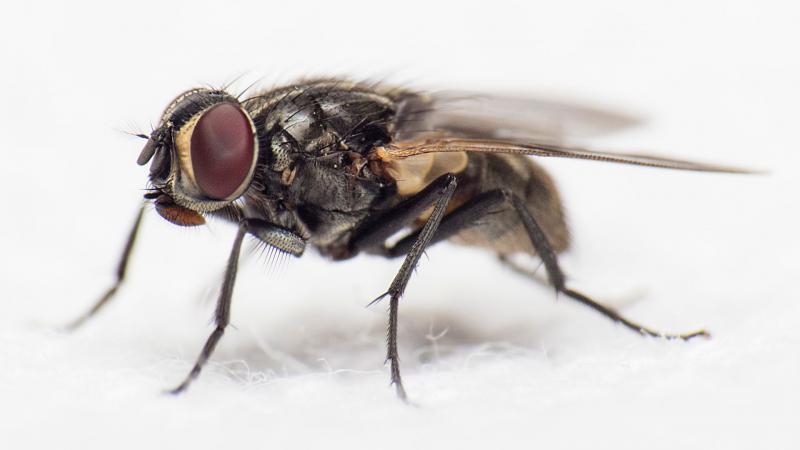
Suitable for use in:
- Butchers
- Fishmongers
- Cafes
- Restaurants
- Delis
- Bakeries
- Pubs
- Suitable for AQIS Inspected meat and food processing plants.
- Racing Horse Stables
- Piggeries
- Hatcheries
- Livestock
- People Safe
- Pets Safe (not suitable cold blooded pets – fish, lizards, snakes etc)
- Registered and approved by the APVMA Product No. 85526
Food Safe Fly Spray Is:
- Fragrance free
- Free from harmful chemicals
- HACCP approved
- Economical
- Unobtrusive
- Child and pet friendly
- Effective in low quantities
- Breaks down rapidly in sunlight
- Is short lived in the environment
- Does not bioaccumulate
Breakdown times vary according to temperature and UV light. Pyrethrin half-life ranges from 1.6 to 3.2 hours. The breakdown products are non-toxic and pose no risk. When breathed in or ingested pyrethrins are metabolised. Braking down into non-toxic metabolites. They are then excreted via bowel and bladder.

A field of pyrethrin daisys
I didn’t know that!
Pyrethrin insect powder has been used for hundreds of years. It was first manufactured in Vienna, Austria in the 1880s. The Fly Lady’s spray is a sustainable green product. Manufactured in Sydney, Australia and approved by the APVMA and HACCP Certified.
It is ideal for eliminating flying pests in restaurant spaces.
Orders shipped Australia wide.
Who is the Fly Lady anyway?
For over a decade The Fly Lady has been protecting restaurants, bars, cafes, pubs and caterers Australia wide from flying pests. Drawing on experience as a fine dining chef she applies her expert knowledge to develop a solution for you that keeps your hospitality space fly free.
“I have had the pleasure of knowing Pip Cleary of over 15 years working for many of Byron Bay’s best known restaurants as a chef, including one of my own. In her business, as The Fly Lady, this experience provides her with much more insight than your ordinary pest exterminator: she specialises in hospitality, and, as an ex-chef she knows restaurants inside out, understanding the needs, health and safety requirements and the people. We have been using her services at Beach Byron Bay with great success, and have reaped the rewards of The Fly Lady’s reliable and friendly service for many years now. We find her all-natural, odour-free product is very effective. And we would definitely highly recommend The Fly Lady to other restaurants or cafes.”

Ben Kirkwood
Beach Byron Bay
Automatic Fly Spray Dispensers and Food Safe Fly Spray
Why solve your fly problem when you can avoid it completely?
FAQ
What is the breakdown time of pyrethrin?
Breakdown times vary according to temperature and UV light. Pyrethrin half-life ranges from 1.6 to 3.2 hours. The breakdown products are non-toxic and pose no risk to warm blooded creatures.
What happens if l ingest food safe fly spray?
The breakdown products are non-toxic and pose no risk. When inhaled or ingested pyrethrins are metabolised. They are broken down into non-toxic metabolites. They are excreted via bowel and bladder.
How long will the dispensers take to work?
Ensure your dispensers are set to 5 minutes. Switch on. Once going, you will notice a significant improvement within 30 minutes.
Use the primer button on dispensers to add extra product into the air. It will help get you off the mark quicker.
How long does a refill last?
Dispensers spray every 5 minutes, 24 hours a day. One refill will last 6 weeks.
Batteries in your dispenser will last for 4-5 refills, possibly more.
How many dispensers will l need?
The number of dispensers required will depend on several factors. These include the area to cover. The breeze through the area and the number of open windows and doors.
Consider the kind of fly you are targeting. Vinegar flies in a bar area? You will need a dispenser below each set of beer taps.
Kitchen spaces. You might require one by the back door. One over the rubbish bin. One covering the front entrance into the kitchen.
Flies are attracted to light and can end up stuck in the front window. In a cafe situation, you can cover the glass front windows.
I can assist you in working this bit out!
The gallery also has some examples of install situations. Look at examples of installation for fly control here
Where should l install them?
Look to install dispensers in stiller air spaces. If installing near an open window or door, ensure the product is not drifting out of the building. Do not install close to air conditioners, air curtains or range hoods.
Common install locations:
- beside the back door
- above wet area rubbish bin
- where the mops and brooms are kept
- dry store
- beneath the bar
- at the end or behind the service counter
- inside or above the front door
**Dispensers require 20-30 cm clearance between them and the ceiling
**Install so the spray does not spray onto anything. It requires clear space all around.
**Dispensers must be installed vertically. They don’t work on their side – I’ve tried!
**Double sided tape is not strong enough to hold them. Use a screw or a zip tie.
How do l install them?
The units come with two screw. You will need both screws if the unit is likely to be stolen. If not, one screw is sufficient. Unit hangs on the screw.
If installing for regular flies, install the dispenser over head. Mount the unit so you can reach the bottom of it without needing a ladder. It keeps the refilling process fast and efficient.
Do dispensers require a power point?
Each unit requires 3 AA batteries.
A fresh set of batteries will last you 4-6 refills, that’s 5-6 months. The units are not battery hungry.
Is there a warranty?
All Biomist units come with a one-year warranty on the mechanical workings. If it should malfunction l will replace it. I will require a photo of the malfunction or the unit to be returned. More about that in the T&C
If a unit is dropped and breaks, that is not covered by the warranty. Please contact me though, I may be able to send you a new case.
If l need help, is there someone l can speak to?
Pip – The Fly Lady
Mb 0439 37 59 44